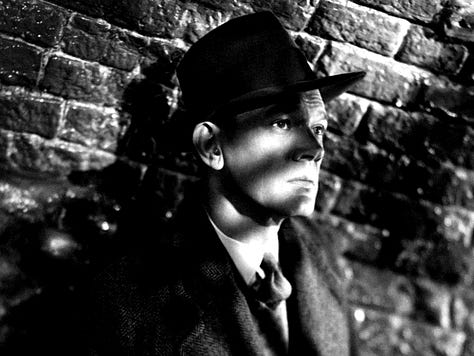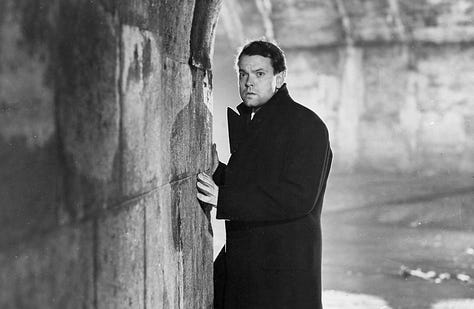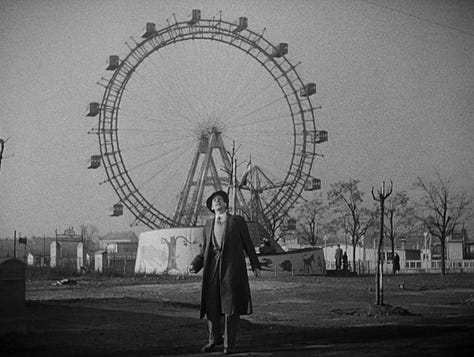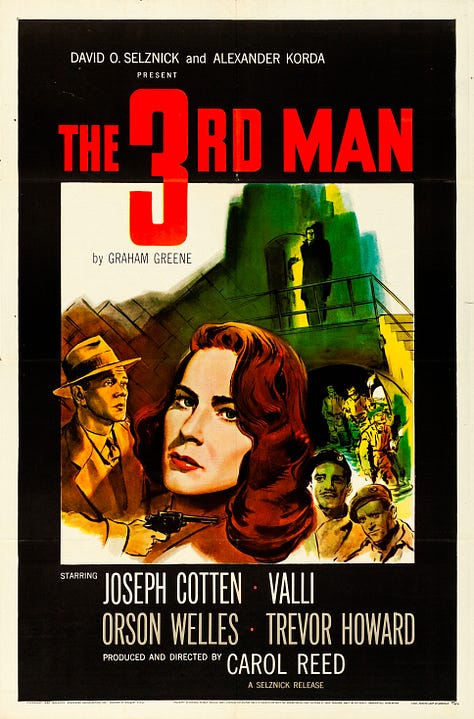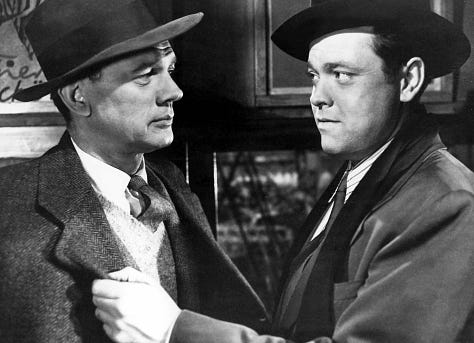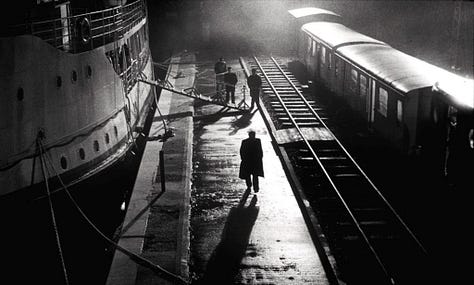THE THIRD MAN
1949 • Carol ReedCast: Joseph Cotten, Alida Valli, Orson Welles, Trevor Howard, Paul Hörbiger, Ernst Deutsch, Erich Ponto, Siegfried Breuer, Hedwig Bleibtreu, Bernard Lee
Screenplay: Graham Greene
Cinematography: Robert Krasker
Music: Anton Karas
British Lion Film Corporation
In Italy for 30 years under the Borgias they had warfare, terror, murder, and bloodshed, but they produced Michelangelo, Leonardo da Vinci, and the Renaissance. In Switzerland they had brotherly love - they had 500 years of democracy and peace, and what did that produce? The cuckoo clock.
American pulp fiction writer named Holly Martins arrives in post-World War II Vienna to meet his childhood friend Harry Lime. However, Martins soon discovers that Lime has been killed in a mysterious accident. As Martins delves into the circumstances surrounding Lime's death, he becomes entangled in a web of deception, corruption, and betrayal. The plot thickens as Martins learns that Lime was involved in a black market racket selling diluted penicillin, resulting in the deaths of innocent people. Martins, along with Lime’s girlfriend Anna Schmidt, investigates his friend’s death and soon uncovers that perhaps there was more to Harry than he let on.
Some Spoilers Ahead
The choice of Vienna as the film's backdrop is perfect. The city's war-torn streets, walkways, and looming edifices become integral elements of the story. Cinematographer Robert Krasker captures the desolation and emptiness of Vienna, turning it into a nightmare world that mirrors the moral ambiguity of the characters. Krasker's cinematography is a visual feast, employing dark shadows and Dutch angles to keep the audience off-kilter. He plays with light and shadow like a paintbrush, thrusting into this dark and seedy black market world.
Of course to talk about the cinematography of the film, one also has to mention Orson Welles' introduction as Harry Lime in the film, a legendarily epic entrance. The brilliance of this reveal lies not only in Welles' self-satisfied smirk but in the cinematography and editing. As the film builds suspense, the anticipation for Harry Lime's appearance reaches a crescendo. When he finally materializes in the shadows of a Vienna doorway, the audience is immediately captivated by Welles' charismatic presence. Dressed in a dark coat and fedora, his face illuminated by the soft glow of a nearby light, Lime is an enigmatic figure whose allure is impossible to resist.
Harry Lime is one of the great all-time villains. Orson Welles' portrayal of Lime is masterful, and the subtlety with which his character is woven into the narrative is brilliant. Despite having only a few scenes, Lime's presence looms large over the entire story. Welles brings a charming and charismatic quality to Lime, making his callous actions all the more disconcerting. He is beguiling, but menacing. The audience doesn't witness Lime's villainy directly but rather experiences its aftermath through the unfolding consequences. This indirect approach to portraying the villain creates a sense of mystery and suspense, as viewers are left to piece together the extent of Lime's wrongdoing. Welles' delivery, marked by his pleasant demeanor, adds complexity to the character. Lime's charisma allows him to manipulate those around him, and the contrast between his charming facade and the darker truths about his actions creates a compelling tension. One can tell the gusto at which Welles attacked this role, especially when he has all the best lines.
The Ferris wheel scene is a pivotal moment where the tension reaches its peak, and the brilliance of Joseph Cotten and Orson Welles as actors shines through. This scene, perched high above Vienna on the Riesenrad Ferris wheel, is a tour de force of acting and character building. As the Ferris wheel ascends, so does the emotional intensity between Cotten's character, Holly Martins, and Welles' Harry Lime. Martins, grappling with the revelations about Lime's illicit activities, confronts his former friend, seeking answers. Welles, in turn, exudes a mix of charm, defiance, and underlying guilt. The scene is a microcosm of the film's broader themes of moral ambiguity and betrayal. The scene ends with Lime’s “cuckoo clock” speech, quoted above, which sums up his character quite well.
Joseph Cotten plays Martins as sort of an amateur detective, perhaps from one of his pulp novels. Martins often stumbles through the investigation, his mistakes contributing to the film's tension, making the unraveling mystery all the more complex. Martins often finds himself in over his head, inadvertently giving vital information to the wrong people and making decisions that compound the mystery rather than solving it. Cotten's performance allows audiences to empathize with Martins' genuine intentions and frustrated confusion.
At the heart of the film's atmospheric brilliance lies Anton Karas' iconic zither score. Its haunting melody sets the tone for the entire film, enhancing the suspense and adding a unique layer to the film. The juxtaposition of this distinctive musical choice against the dark, post-war backdrop of Vienna creates an unforgettable auditory experience.
The climactic tunnel chase sequence is a triumphant convergence of cinematography, editing, and sound design. As the film hurtles toward this climax, this sequence showcases the technical brilliance that elevates the film to the pinnacle of the film noir genre. The cinematography shines through in the tunnel chase. The narrow, labyrinthine tunnels casts haunting silhouettes and stark contrasts that heighten the tension. The editing, orchestrated with precision, propels the chase forward with relentless momentum. Each cut and transition is a carefully calculated step. Even though narratively, the villain must be caught, placing the viewer in Lime’s shoes as he attempts to escape, makes the viewer almost want him to escape. With each dead end or trapped corner, Lime as well as the audience, feels panic. The seamless integration of shots, coupled with the rhythmic pacing, intensifies the urgency of the pursuit. Sound design emerges as another crucial element, contributing to the overall sensory experience of the chase. The echoing footsteps, and the distant reverberation of voices, all coalesce to create a sonic landscape that mirrors the suspense on screen. Lime is disoriented, thus the audience is disoriented.
The Third Man is a perfect film noir. Lime’s introduction and his subsequent downfall in the sewers are enough to make the film an all-time classic. Luckily, the film also offers a wealth of dark treasures that reward each subsequent viewing.
Oh, I still do believe in God, old man. I believe in God and Mercy and all that. But the dead are happier dead. They don't miss much here, poor devils.
Notable Awards & Accomplishments
Academy Award Winner: Best Cinematography
Academy Award Nominee: Best Director
Academy Award Nominee: Best Film Editing
Streaming: Criterion Channel, Tubi, Crackle, Indie Flix
Digital Rental/Purchase: Available at major digital retailers
Physical Media: Available on Blu-Ray and DVD; Part of the Criterion Collection

